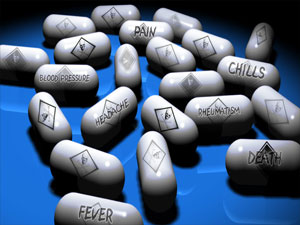Prescription drug abuse on the rise worldwide
By Haider Rizvi | Last updated: Jul 11, 2011 - 10:27:53 AMWhat's your opinion on this article?

|
“Yes, Afghanistan is on top of the list,” Thomas Pietschmann, a researcher at the UN Office on Drugs and Crime (UNODC), told IPS.
Last year, more than 210 million people around the world used illegal substances such as heroin, cocaine and cannabis, as well as prescription opioid drugs and new synthetic drugs, the report said. But while global markets for cocaine, heroin and cannabis declined or remained stable, the production and abuse of prescription drugs rose.
“The gains we have witnessed in the traditional drug markets are being offset by a fashion for synthetic ‘designer drugs' mimicking illegal substances,” said UNODC Executive Director Yury Fedotov.
On June 23, Mr. Pietschmann and colleagues launched the latest annual UN report on drugs and crime, which notes that Afghanistan remains the leading supplier of heroin in the world market for narcotic drugs.
The 313-page report points out that although there was sharp decline in opium production and a “modest” reduction in coca cultivation, the amount of heroin and cocaine produced and sold last year was still “significant.”
The report's authors say the area under poppy cultivation in Afghanistan may have “remained stable” in 2011, but add that this trend was unlikely to continue.
Afghanistan continues to be the world's major supplier of heroin, despite actions taken by the Western-backed government in Kabul to crack down on the production of poppy and a blight that wiped out much of the opium harvest there.
In response to an IPS question about how the world community can assist poppy growers in Afghanistan to transition to other means of livelihood, Mr. Fedotov suggested the government in Kabul needed to take drastic steps.
“(There is) the lack of rule of law and corruption,” he said, adding that these two major factors were chiefly responsible for continuing growth of poppy crops in Afghanistan.
Experts say that in addition to the illicit cultivation, manufacturing and export of heroin, Afghanistan faces the problem of drug abuse at the domestic level.
A recent nationwide survey found that there were at least one million drug addicts in that war-torn Central Asian country. Those statistics also include some 60,000 children under the age of 15.
Mr. Fedotov noted that much of the poppy crop in Afghanistan is being produced on private lands owned and controlled by feudal landlords who exercise full control over poor peasants' work-life.
About the use and production of cocaine, the report's authors said they noted that the use of cocaine produced in South American countries declined last year and that drug cartels were losing profits.
Although the U.S. cocaine market has witnessed massive declines in recent years, the report said, it continues to be the largest cocaine market, with an estimated consumption of 157 tons of cocaine in 2009.
When asked about the calls by some rights groups in the United States and Europe to legalize drugs like cocaine and heroin, whose users often face lengthy prison sentences for nonviolent crimes, both officials from the UN drug office were tight-lipped. Mr. Fedotov said, however, that it was “up to the (UN) member states to decide.”
Shortly before the launch of the study, UN Secretary-General Ban Ki-Moon told a select gathering in New York that drug trafficking had transformed in recent years into a “major threat” to the “security and health of people and regions.”
In his view, the $61 billion annual market for Afghan opiates was funding “insurgency, international terrorism, and wider destabilization.”
In West Africa, he said, the $85 billion global cocaine trade was exacerbating addiction and money laundering, while fueling political instability and threats to security.
“Every $1 billion of pure cocaine trafficked through West Africa earns more than 10 times as much when sold on the streets of Europe,” he added in a statement.
INSIDE STORIES AND REVIEWS
-
-
About Harriett ... and the Negro Hollywood Road Show
By Rabiah Muhammad, Guest Columnist » Full Story -
Skepticism greets Jay-Z, NFL talk of inspiring change
By Bryan 18X Crawford and Richard B. Muhammad The Final Call Newspaper @TheFinalCall » Full Story -
The painful problem of Black girls and suicide
By Charlene Muhammad -National Correspondent- » Full Story -
Exploitation of Innocence - Report: Perceptions, policies hurting Black girls
By Charlene Muhammad -National Correspondent- » Full Story -
Big Ballin: Big ideas fuel a father’s Big Baller Brand and brash business sense
By Bryan Crawford -Contributing Writer- » Full Story






 Click Here Stay Connected!
Click Here Stay Connected!








